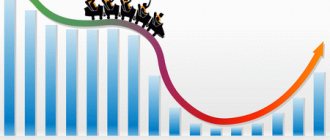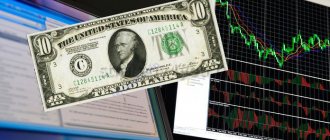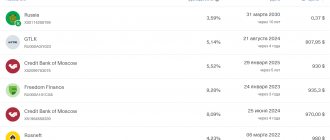Types of investment risks
Depending on the cause of their occurrence, investment risks are divided into:
- Economic. Depend on the general state of the state's economy, as well as its policies regarding the management of markets, taxes and finances.
- Technological. They relate primarily to manufacturing enterprises and depend on the reliability of equipment, the pace of its modernization, the level of automation, and the speed of innovation.
- Social. Social tensions, strikes, and the implementation of regional or federal social programs may affect specific investments. This type of risk is most determined by the human factor.
- Political. The internal life of the country also has an important influence on the implementation of investment projects. The main factors of this group include: a sharp change in the main political course, elections, pressure on the country from other states, introduced administrative restrictions, deterioration of interstate relations.
- Legal. Associated with changes in legislation that may affect the results of investment projects. Legal risks include a reduction in the key rate of the Central Bank, an increase in customs duties, and licensing of certain types of activities.
- Ecological. This group includes factors associated with man-made disasters, pandemics, climate change, and natural disasters.
There are also other ways to qualify investment risks. For example, they are often divided into systemic (exist on a market scale and do not depend on the actions of the investor) and non-systemic (related directly to the object in which funds are invested).
Pursuit of profitability
All investors want to receive high returns, but many forget about risks. There is a saying “greed leads to poverty.”
Do you think that a yield of 15-20% per annum is low? Are you offered to invest money and receive 40% or more interest per annum?
Carefully! You risk losing money in a financial pyramid! Because of the thirst for easy money, Russians lost more than 2.7 billion rubles in financial pyramids in 2022! No wonder they say that free cheese comes in a mousetrap.
The higher the promised return, the higher the risks.
Before investing money, assess the risks, carefully study the contract and information about the company you will work with.
What are the risks when trading securities?
For this group of investments, the risks are somewhat different, so we will talk about them separately. They are divided into two groups: macro risks and micro risks.
Macro risks, in turn, include:
- Systemic (related to the market as a whole). If an economic crisis or default develops in a country, this affects all financial instruments, regardless of their type.
- Regional. It is important to assess such risks when investing in shares of large city-forming enterprises or, for example, municipal bonds.
- Industry. They exert influence when purchasing shares of companies in a particular industry.
Micro risks are risks associated with a specific issuer or exchange instrument. These include:
- Market risk. Associated with changes in securities prices in response to external events.
- Interest rate risk. Determined by changes in interest rates that affect the market value of an investment.
- Liquidity risk. This is the risk of not being able to convert your investment into cash without a significant loss of your invested capital.
- Business risk. It implies uncertainty about the company's future financial results, that is, the likelihood that its profits may decrease for one reason or another.
Market risk
Systemic and non-systemic market risk
As I already wrote in the article about asset classes and stock indices, market risk can be systemic and non-systemic:
- Unsystematic risk is the risk of individual assets (securities), also called individual issuer risk or idiosyncratic risk . For example, if you buy an individual security, its issuer (company) may go bankrupt, resulting in the loss of part of the invested capital. Or the company's business will not go as well as expected, and its stock will bring less profit.
- Systemic risk is the risk of all securities in a particular market in the aggregate, that is, market risk. For example, the risk of the stock market of Russian public companies, US government bonds or shares of companies from all developed countries can be called systemic.
Risk can be measured in many ways, but the most common way to measure it is volatility - a measure of the variability of an asset's price over time.
According to research, and even simple calculations that many investors have done on their own, as the number of shares of companies from a particular market in a portfolio increases, its risk, expressed in volatility, quickly approaches the systemic risk of that market.
For different markets and periods, this number of shares may vary, but if you take any stock market from hundreds and even thousands of securities, then you can say that even with 30 shares in the portfolio, volatility
.
It is important not to confuse volatility and profitability , because volatility similar to the market in a portfolio of several dozen stocks does not mean identical to the market return. In markets where thousands of stocks are traded, you will need to include many more stocks in your portfolio to achieve market returns. This is due to the shape of the stock return distribution curve.
Most stocks have mediocre returns and only a few provide the lion's share of them, pushing market returns to the level that everyone has come to expect. However, to get a very accurate approximation to market returns, you don’t need to buy absolutely all the securities on the market.
Standard deviation
Let's return to volatility as a measure of risk. Random variables have a mathematical expectation - this is the arithmetic mean of random outcomes. The spread of values of a random variable is called variance , and the square root of the variance is called standard deviation . Another name for it is standard deviation or standard deviation. It is denoted by the lowercase Greek letter sigma – σ.
Let's consider the calculation of all these quantities using a simple example. Let's imagine that we have a coin and we toss it 10 times. We took tails as zero, and heads as one and got the following set of random values: 0, 0, 1, 1, 1, 0, 0, 1, 0, 1.
The mathematical expectation (arithmetic mean) in this case was 0.5, expected for a coin











